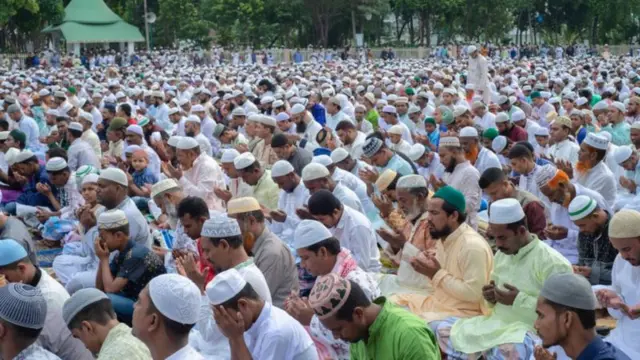According to the history of Islam, animal sacrifices have been practiced since the time of Prophet Adam or Prophet Abraham, but the practice of sacrificing animals was introduced after several years like Eid-ul-Fitr or fasting.
According to Islamic experts, sacrifices were offered in Mecca every year. But then the inhabitants of Makkah used to sacrifice them in the name of various gods and goddesses. As a result, even if the Prophet of Islam was in Mecca at that time, he did not follow this custom.
After the migration to Madinah about thirteen years after receiving Prophethood, the ritual of sacrifice was formally introduced.
Maulana Md. Abu Saleh Patwari, deputy director of the Islamic Foundation’s Halal Sanad Department, told BBC Bangla, “Many of the rules of Islam came into force after the arrival of the Prophet (PBUH) in Madinah. Because after he started preaching Islam, establishing unity among the people of Makkah was the primary task. And after he migrated to Madinah, the rules of Islam were promulgated.
Fasting and Eid-ul-Fitr were introduced in the second year of Hijri. However, the people of Madinah used to celebrate festivals and fasts in the same way even before that.

IMAGE SOURCE,GETTY IMAGES
Md. Ataur Rahman Miazi, professor of Islamic History and Culture Department of Dhaka University, said that Eid was introduced in the second year of Hijri.
Quoting a hadith narrated by Anas, a companion or companion of the Prophet Muhammad, Banglapedia, the national encyclopedia of Bangladesh, says that after visiting Medina, the Prophet saw that the people there celebrated two major festivals a year.
He then wants to know, what are the festivals?
These were two festivals called Nowroz and Mihirjan – one in autumn and the other in spring according to the religion and caste customs of the inhabitants.
Prof. Miyaji said, “Then the practice of celebrating two religious, social and national festivals in a year was introduced for Muslims on the pattern of those two festivals.”
One of those two Eids was observed during Hajj, known as Eid-ul-Azha.
However, exact information is not available about when and how the first sacrifice was made after the spread of Islam.

IMAGE SOURCE,GETTY IMAGES
Some historians say that after coming to Medina, the Prophet of Islam sacrificed the first two dumbas with his own hands. Then he said, one from my own side and another from the side of our Ummah.
Maulana Md. Abu Saleh Patwari said, “Many things in Islam have been done according to the customs of the previous prophets. For example, initially prostration towards Baitul Moqaddes, but later prostration towards the Kaaba according to the example of Ibrahim (as). The issue of sacrifice has also come.
He says, “According to the Qur’an and Hadith of Islam, sacrifice began with Adam (as). However, instructions to sacrifice are found in Surah Kawsar and Surah Hajj. This Surah Qawsa was revealed before the Hijrah, when the Prophet (PBUH) was in Makkah. And Surah Hajj is believed to have been revealed together in Makkah and Madinah.
Sacrifice is ordered in these two Surahs.
Mr. Patwari says, “From this it is understood that the subject of sacrifice came from the time when the Prophet (PBUH) was in Makkah.”
However, there is no official information about when he first sacrificed.
Maulana Md. Abu Saleh Patwari says, “It is mentioned in Tirmidhi Hadith, Abdullah Ibn Omar said that after Hijrah, the Prophet (PBUH) stayed in Madinah for 10 years and sacrificed in 10 years. And Anas Ibn Malik said, Rasulullah (SAW) slaughtered two-horned Nadus-Nudus Dumba and said one from my Ummah and one from me.”
It is said in another hadith, he used to sacrifice two dumbas, Mr. Patwari.
Scholars or experts say that at that time the issue of sacrifice was very much centered on Hajj.
Those who went for Hajj or Umrah, used to take animals like camels or camels with them for sacrifice. These animals were called Hadi.
Professor Md. Ataur Rahman Miyaji of Dhaka University’s Department of Islamic History and Culture tells BBC Bangla, “When Rasul (PBUH) left for Umrah in the sixth Hijri or 628 AD, when he was stopped at Hudaybiya, he stayed in a tent. When the treaty of Hudaybiyyah was concluded, he sacrificed a camel for himself and his family.
It is said that he sacrificed 63 camels during this time.
At that time, information on sacrificing camels, buffaloes, cows, goats, sheep and goats was found in the rules of Islam.
In this regard, Maulana Md. Abu Saleh Patwari said, “He was going to perform Umrah in the sixth Hijri, at that time there was a rule to take animals with him. Then there was another custom other than sacrifice. The animals were marked on the chest and released towards Mecca, so that it was understood that they were sacrificial animals. After the Treaty of Hudaybiyah, some animals were sacrificed, and some animals were released with a scar on their chest.
Mr. Patwari says, “After the conquest of Makkah in 10 Hijri, the Prophet (PBUH) himself formally performed Hajj and performed Qurbani.”
In the previous year, a group led by Companion Abu Bakr was sent for Hajj. With that party there was an ox or an animal for sacrifice.